12 Types of Ladybugs
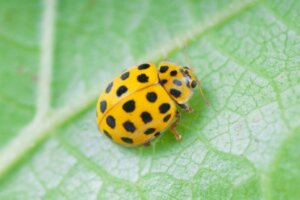

Written and verified by the biologist Samuel Sanchez
Ladybugs, scientifically designated as coccinellids, are a family of cosmopolitan coleopteran insects that encompass more than 6,000 species. Although the most famous and well-known species is Coccinella septempunctata, it should be noted that there are many other types of ladybugs, with very different colors and body patterns.
Ladybugs are considered pest controllers in many regions, as they prey on aphids, plant bugs (Coccoidea), spider mites, and other invertebrates that damage crops. However, some species of coccinellids can become a pest by themselves if they’re introduced into foreign environments. If you want to know more, keep reading.
Characteristics about ladybugs
Ladybugs are coleopterans (order Coleoptera) and share a group with typical beetles. This order is the largest in the entire animal kingdom, comprising 40% of all insects and 25% of all living animal beings. Of the more than 400,000 species included in this taxon, about 6,000 are coccinellids.
All these insects have 6 legs, are 0.8 to 18 millimeters long, and have a curved shape, with functional elytra —wings— that line the abdomen. Depending on the species, they may have colored patterns with pits, stripes, vertical lines, or just a general color.
The life cycle of ladybugs
The ladybug life cycle is very fast, as it takes about 4 weeks to complete. This allows multiple generations to overlap in a single summer, as females are capable of laying 200 to 300 eggs between spring and summer.
However, what not everyone knows is that ladybugs go through a larval stage that lasts about a month. After feeding on aphids, mites or larvae of other coleopterans – up to 250 a day – the coccinellid larvae enter a pupal stage, which lasts about 15 days. Adults emerge from the pupa, with a life expectancy of approximately 1 year.
Types of ladybugs
As we’ve said, there are more than 6000 species of coccinellids in the world. We’ll tell you about six of the most curious and well-known ones, and then we’ll mention a few more briefly. Don’t miss it!
1. 7-point ladybird (Coccinella septempunctata )
Coccinella septempunctata is the most common ladybird species throughout Europe. This invertebrate has red elytra with 3 points on each wing, in addition to another that appears near the cephalic region, at the junction between the two. For this reason, it’s known as the “7-point ladybug”. This species has a huge ecological range, as long as there are aphids it can feed on.
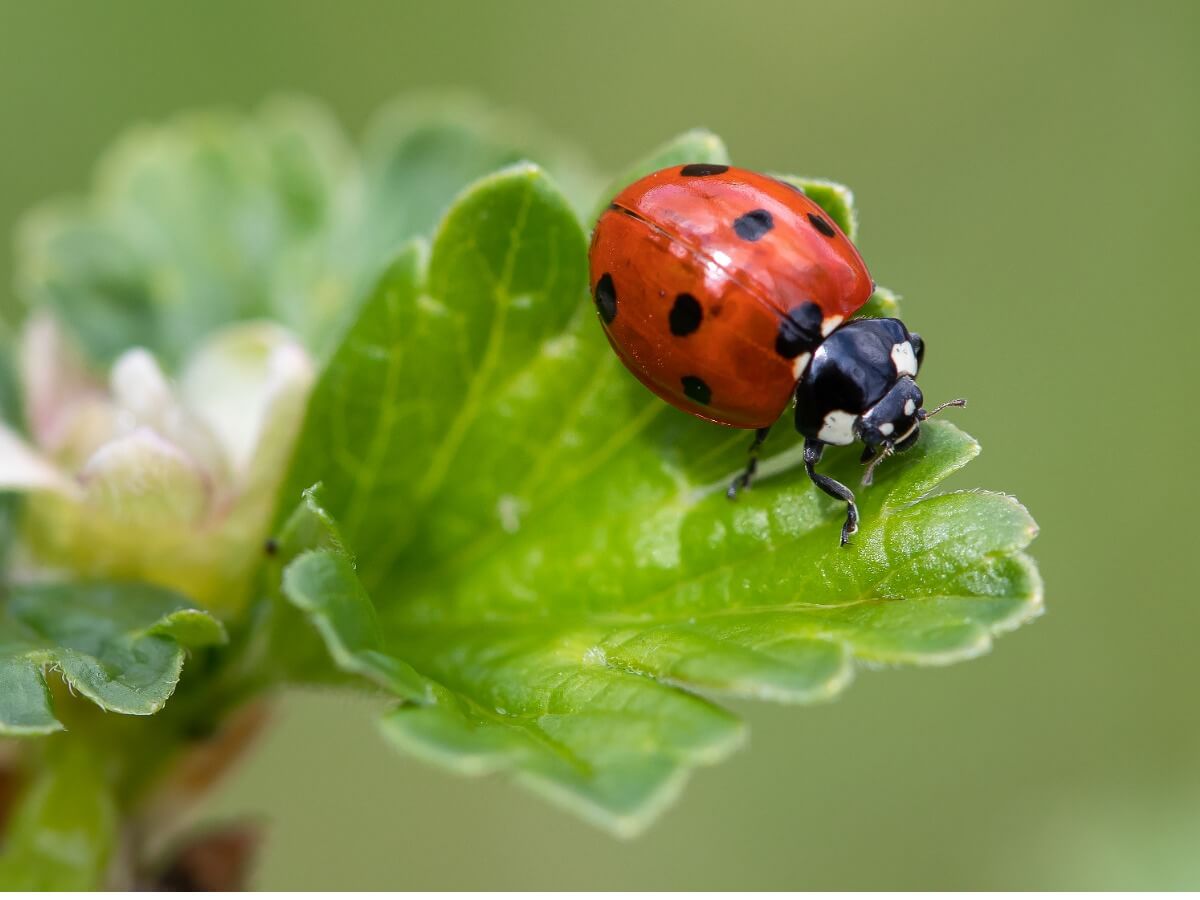
2. 2-point ladybird (Adalia bipunctata)
This species has a similar morphology to the previous case, but with two distant points, one on each elytra – hence its scientific name. It’s found in western and central Europe, in addition to certain regions of North America. Unfortunately, it’s becoming increasingly difficult to find in the United States.
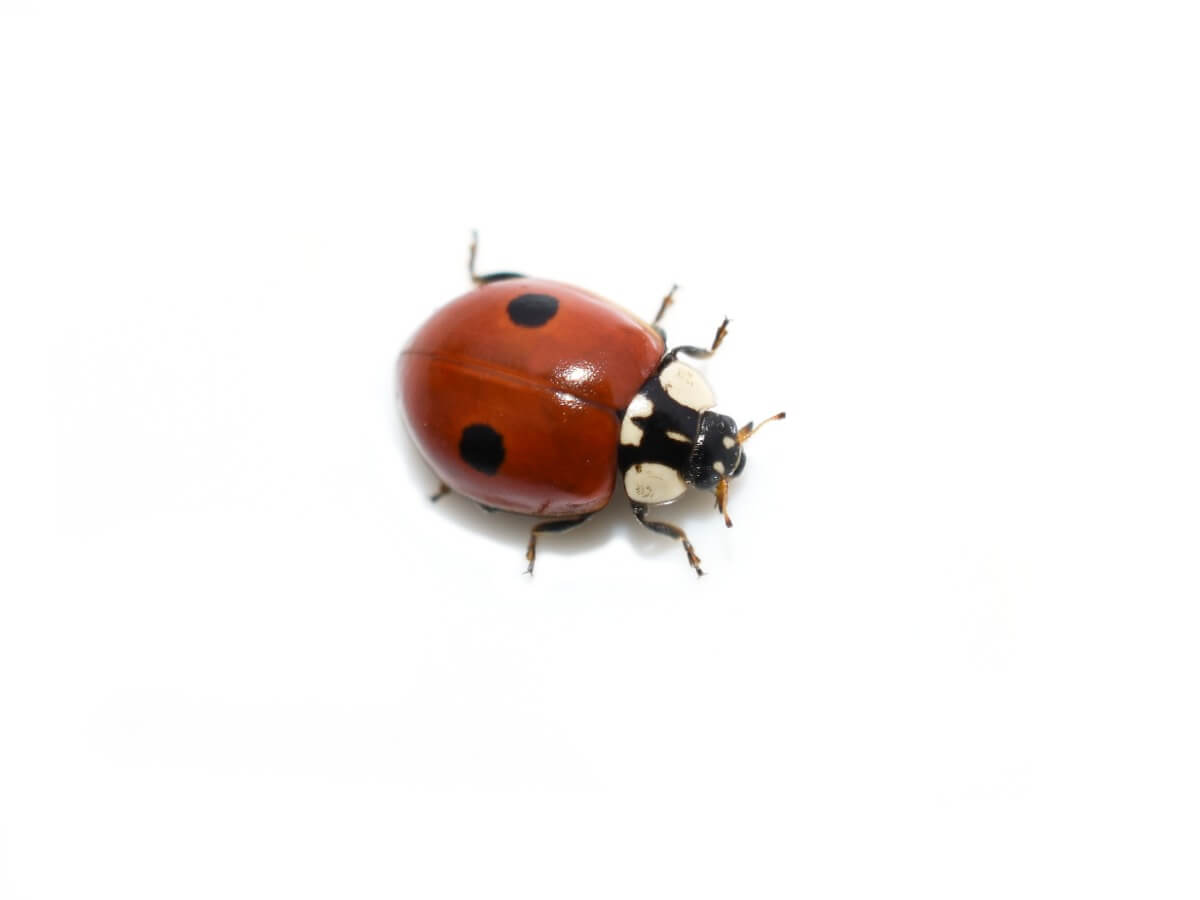
3. Transverse ladybird (Coccinella transversalis )
This species, of atypical appearance and very different from European ladybugs, is found from India, through South and Southeast Asia, to Malaysia and Australia. It’s 3.8 to 6.7 millimeters long and has very little variability between populations. It draws attention for its reddish base color, with black bands that delimit the midline of its wings.

4. 22-point ladybird (Psyllobora vigintiduopunctata )
Oddly enough, we go from tomato red to garish yellow. This species of beetle still belongs to the coccinellidae family, but it has distinctive yellow elytra and the larva’s hue is also this color. Each elytra is adorned with 11 black points – 22 in total – and the pronotum region (white) adds another 5 points.
Unlike the other species, this one isn’t a predator of aphids and other invertebrates. It feeds on fungi that grow on plant tissues.
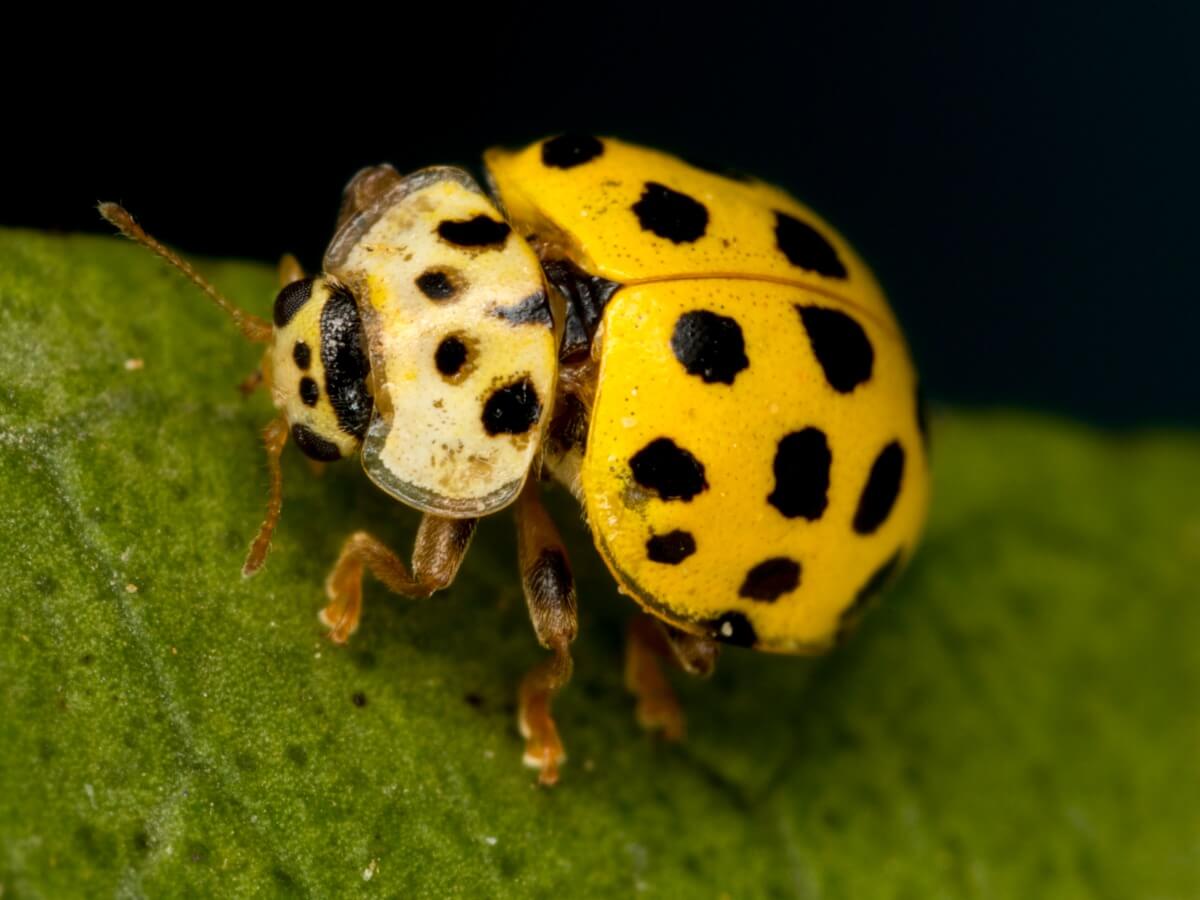
5. Multicolored Asian ladybug ( Harmonia axyridis )
This species, native to Asia and introduced to North America for pest control, has become a pest in many of the regions where it isn’t native. As indicated by the Invasive Species Compendium (CABI) portal, the first specimens were introduced in this country in 1916, but it wasn’t until the eighties when they began to become a problem.
The multi-colored Asian ladybug has invaded American ecosystems and is a problem for local wildlife. Due to its resistance and prolific potential, it has displaced other species of coccinellids that are endemic.
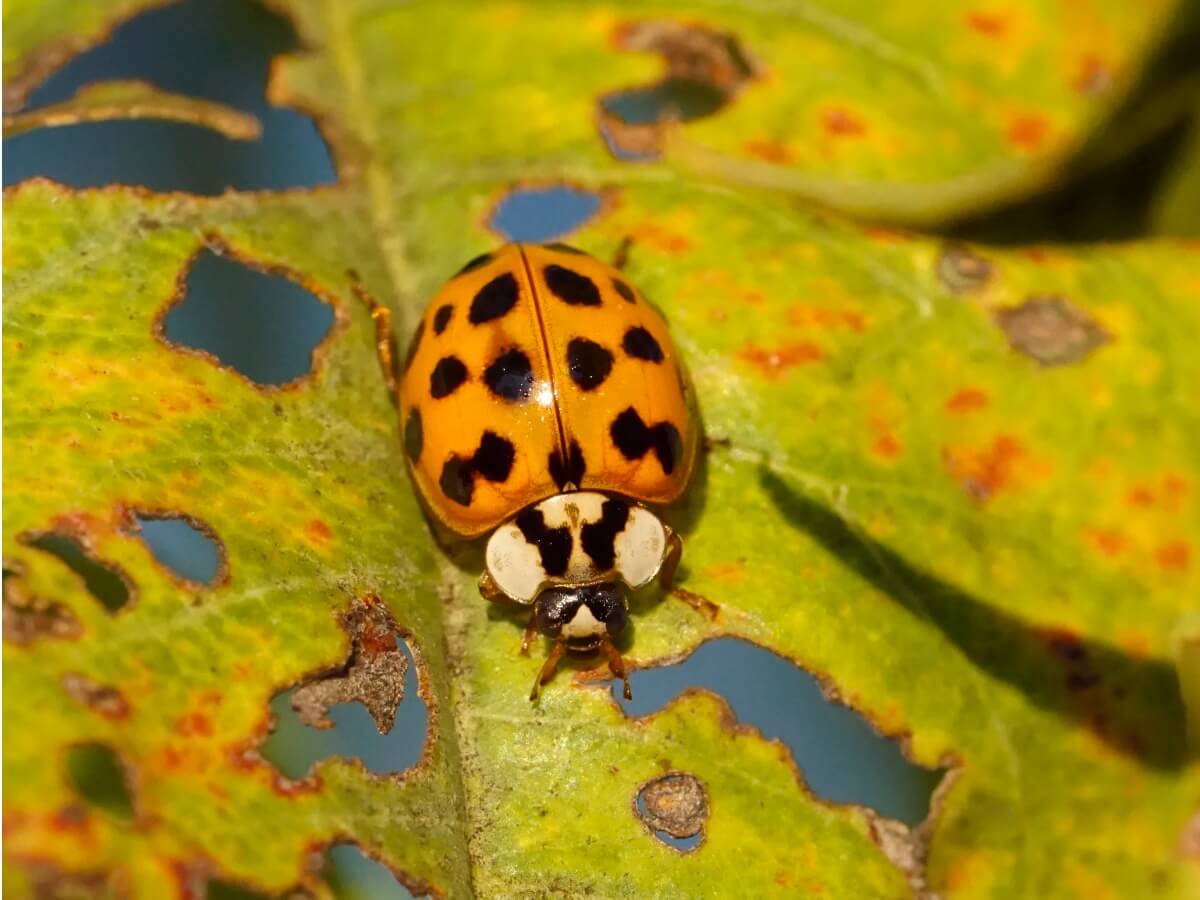
6. Pink ladybug (Coleomegilla maculata)
The pink ladybug is endemic to North America, found throughout much of New York, southern Ontario, and many other states. Its shape is oval, it has 6 points in each of the elytra and has a background color that ranges from orange to red.
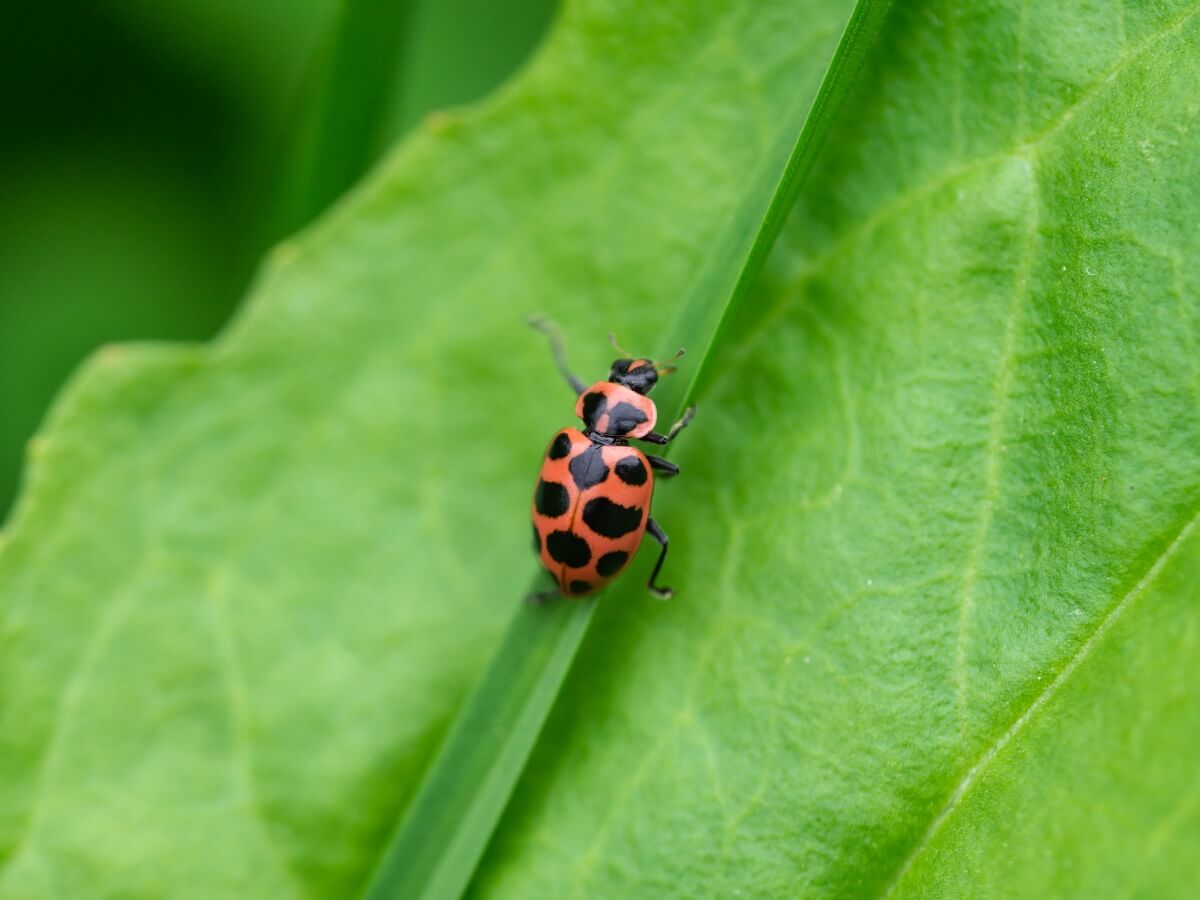
Other types of ladybugs
Due to their beautiful colors and striking hues, ladybugs are one of the most famous groups of coleopterans in the world. We have told you about six of the most famous species, but remember that there are up to 6000. To cover a little more taxonomic terrain, we’ll tell you about a few more:
- Papuaepilachna guttatopustulata: Apart from its color, this species is striking for being herbivorous. Both adults and larvae feed on the leaves of nightshade plants.
- Brumoides suturalis: This species stands out for its color pattern. It features a metallic gold background with black lines.
- Hippodamia tredecimpunctata: As its name suggests, this species has 13 spots divided between both elytra. It is found in Europe, North Africa, and many other regions.
- Hippodamia convergens: This ladybug is native to North America, but it has been introduced to South America to kill aphid pests.
- Anatis ocellata: This species stands out for having white halos surrounding the black pits of the elytra.
- Novius cardinalis: One of the ladybugs that has been used the most to kill crop pests, due to its predatory specialization, especially directed at the Icerya purchasi species.
There are many types of ladybugs. Most are aphid predators, but there are others that are herbivorous or fungus-eating.
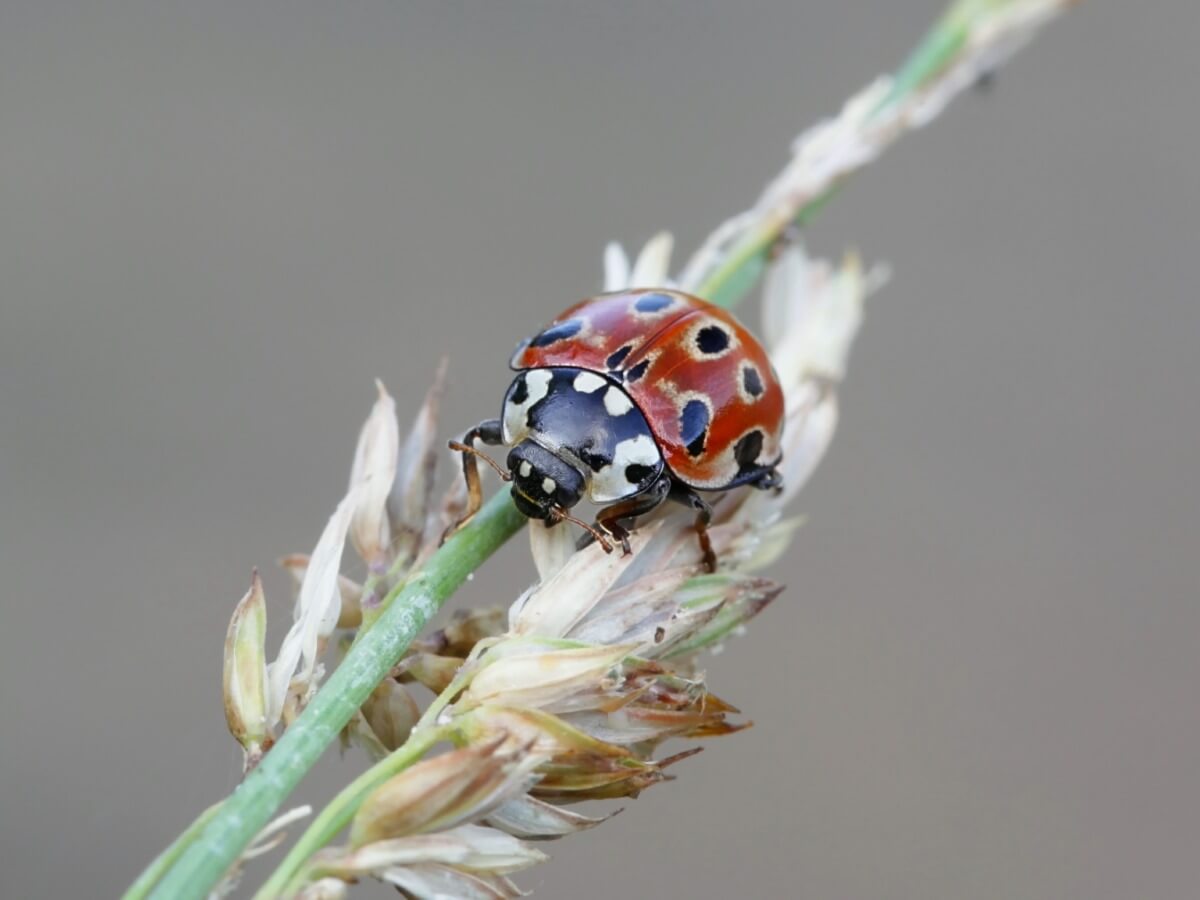
As you can see, ladybirds are far more than just a small beetle with 7 black dots on their wings. Coccinella septempunctata is the most famous of all, but ladybirds stand out for their variety.
Ladybugs, scientifically designated as coccinellids, are a family of cosmopolitan coleopteran insects that encompass more than 6,000 species. Although the most famous and well-known species is Coccinella septempunctata, it should be noted that there are many other types of ladybugs, with very different colors and body patterns.
Ladybugs are considered pest controllers in many regions, as they prey on aphids, plant bugs (Coccoidea), spider mites, and other invertebrates that damage crops. However, some species of coccinellids can become a pest by themselves if they’re introduced into foreign environments. If you want to know more, keep reading.
Characteristics about ladybugs
Ladybugs are coleopterans (order Coleoptera) and share a group with typical beetles. This order is the largest in the entire animal kingdom, comprising 40% of all insects and 25% of all living animal beings. Of the more than 400,000 species included in this taxon, about 6,000 are coccinellids.
All these insects have 6 legs, are 0.8 to 18 millimeters long, and have a curved shape, with functional elytra —wings— that line the abdomen. Depending on the species, they may have colored patterns with pits, stripes, vertical lines, or just a general color.
The life cycle of ladybugs
The ladybug life cycle is very fast, as it takes about 4 weeks to complete. This allows multiple generations to overlap in a single summer, as females are capable of laying 200 to 300 eggs between spring and summer.
However, what not everyone knows is that ladybugs go through a larval stage that lasts about a month. After feeding on aphids, mites or larvae of other coleopterans – up to 250 a day – the coccinellid larvae enter a pupal stage, which lasts about 15 days. Adults emerge from the pupa, with a life expectancy of approximately 1 year.
Types of ladybugs
As we’ve said, there are more than 6000 species of coccinellids in the world. We’ll tell you about six of the most curious and well-known ones, and then we’ll mention a few more briefly. Don’t miss it!
1. 7-point ladybird (Coccinella septempunctata )
Coccinella septempunctata is the most common ladybird species throughout Europe. This invertebrate has red elytra with 3 points on each wing, in addition to another that appears near the cephalic region, at the junction between the two. For this reason, it’s known as the “7-point ladybug”. This species has a huge ecological range, as long as there are aphids it can feed on.

2. 2-point ladybird (Adalia bipunctata)
This species has a similar morphology to the previous case, but with two distant points, one on each elytra – hence its scientific name. It’s found in western and central Europe, in addition to certain regions of North America. Unfortunately, it’s becoming increasingly difficult to find in the United States.

3. Transverse ladybird (Coccinella transversalis )
This species, of atypical appearance and very different from European ladybugs, is found from India, through South and Southeast Asia, to Malaysia and Australia. It’s 3.8 to 6.7 millimeters long and has very little variability between populations. It draws attention for its reddish base color, with black bands that delimit the midline of its wings.

4. 22-point ladybird (Psyllobora vigintiduopunctata )
Oddly enough, we go from tomato red to garish yellow. This species of beetle still belongs to the coccinellidae family, but it has distinctive yellow elytra and the larva’s hue is also this color. Each elytra is adorned with 11 black points – 22 in total – and the pronotum region (white) adds another 5 points.
Unlike the other species, this one isn’t a predator of aphids and other invertebrates. It feeds on fungi that grow on plant tissues.

5. Multicolored Asian ladybug ( Harmonia axyridis )
This species, native to Asia and introduced to North America for pest control, has become a pest in many of the regions where it isn’t native. As indicated by the Invasive Species Compendium (CABI) portal, the first specimens were introduced in this country in 1916, but it wasn’t until the eighties when they began to become a problem.
The multi-colored Asian ladybug has invaded American ecosystems and is a problem for local wildlife. Due to its resistance and prolific potential, it has displaced other species of coccinellids that are endemic.

6. Pink ladybug (Coleomegilla maculata)
The pink ladybug is endemic to North America, found throughout much of New York, southern Ontario, and many other states. Its shape is oval, it has 6 points in each of the elytra and has a background color that ranges from orange to red.

Other types of ladybugs
Due to their beautiful colors and striking hues, ladybugs are one of the most famous groups of coleopterans in the world. We have told you about six of the most famous species, but remember that there are up to 6000. To cover a little more taxonomic terrain, we’ll tell you about a few more:
- Papuaepilachna guttatopustulata: Apart from its color, this species is striking for being herbivorous. Both adults and larvae feed on the leaves of nightshade plants.
- Brumoides suturalis: This species stands out for its color pattern. It features a metallic gold background with black lines.
- Hippodamia tredecimpunctata: As its name suggests, this species has 13 spots divided between both elytra. It is found in Europe, North Africa, and many other regions.
- Hippodamia convergens: This ladybug is native to North America, but it has been introduced to South America to kill aphid pests.
- Anatis ocellata: This species stands out for having white halos surrounding the black pits of the elytra.
- Novius cardinalis: One of the ladybugs that has been used the most to kill crop pests, due to its predatory specialization, especially directed at the Icerya purchasi species.
There are many types of ladybugs. Most are aphid predators, but there are others that are herbivorous or fungus-eating.

As you can see, ladybirds are far more than just a small beetle with 7 black dots on their wings. Coccinella septempunctata is the most famous of all, but ladybirds stand out for their variety.
All cited sources were thoroughly reviewed by our team to ensure their quality, reliability, currency, and validity. The bibliography of this article was considered reliable and of academic or scientific accuracy.
- Carle, E., & Barden, C. (1996). The grouchy ladybug. New York: HarperCollins.
- Hodek, I., & Honêk, A. (2013). Ecology of coccinellidae (Vol. 54). Springer Science & Business Media.
- Hodek, I. (2013). Biology of coccinellidae. Springer Science & Business Media.
- Obrycki, J. J., & Kring, T. J. (1998). Predaceous Coccinellidae in biological control. Annual review of entomology, 43(1), 295-321.
- Gordon, R. D. (1985). The Coccinellidae (Coleoptera) of America north of Mexico. Journal of the New York Entomological Society, 93(1).
This text is provided for informational purposes only and does not replace consultation with a professional. If in doubt, consult your specialist.








